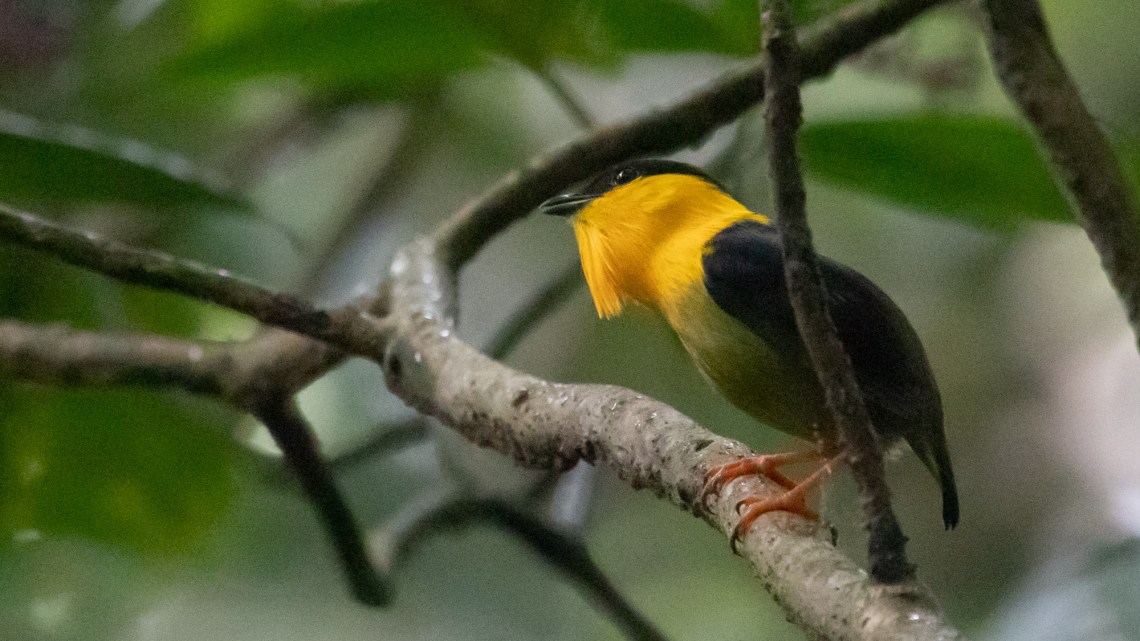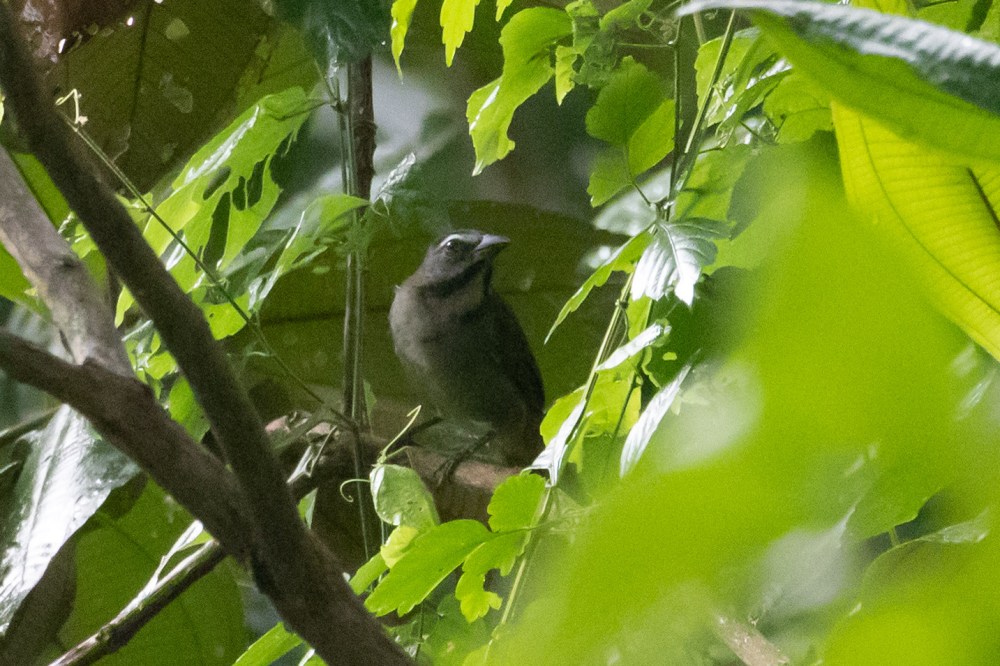
Panamania Day 3: Old Gamboa Road to Plantation Road
Old Gamboa Road had a lot to live up to after Pipeline Road. Unfortunately, the weather was less cooperative this day. Panama has two seasons, the dry season (Jan-Apr), and the rainy season (May-Dec). Our trip happened to be during the rainy season. Lucky for low crowds, cooler temps, and fewer biting insects, but unlucky for unpredictable weather, lower than normal light conditions, and maybe less active birds outside breeding season. But, we knew it would be an adventure, no matter the weather.

It started out nice and we listened to Isthmian Wrens (they look just like Bewick’s Wrens!), Clay-colored Thrush, and Dusky Antbirds singing from the vegetation by the main road. We then walked to the Summit Ponds. Old Gamboa Road is located on the southern most part of Soberanía National Park and this part of the road to the ponds is public, but it is also near the State Border Service, and Saul had to ask station guards nicely if it was okay for us to park and “buscar pájaros,” look for birds.
Fun fact, Panama has no active military service, it was abolished after the U.S. invasion in 1989 overthrowing their corrupt military dictator. The mission was effective but controversial due to the casualties and damage to the city, and did you know the U.S. military played loud music for days to “smoke out” the dictator? “Give It Up,” by K.C. And The Sunshine Band, “Welcome to the Jungle,” by Guns N’ Roses, “Wanted Dead Or Alive,” by Bon Jovi. I can’t make this stuff up. But I digress, no army, but Panama does have intimidating armed officers in camo keeping Boat-billed Herons secure.
Thankfully, they let us through.

We scanned the ponds and Saul immediately found the gray lumps on the far side of the pond. Boat-billed Herons!

Oof. It was almost as satisfying as looking at Black-crowned Night Herons at home. The herons weren’t showing us their boat-bills, but we had a chance to check on the way out to see if they turned around. We had a consolation Rusty-margined Flycatcher here instead.

The American Pygmy Kingfisher was a no-show, but we had a very active Green Kingfisher.

It was the ponds of consolation. But we’d just started and there was time for much more. We climbed around a gate and headed down the road. We got bad looks at a Chestnut-headed Oropendola and Masked Tityra but after this we witnessed a dreamy male Golden-collared Manakin.

Hola! There was a group of manakins practicing their routines and making wing snap sounds, that when muffled in the forest may sound like manakin farts. A fun video of them here.
We had our best chance at Spectacled Owl on Old Gamboa Road, Saul had seen them the week prior, and oh how I wanted to see them too, but true to owls, they were not where they were supposed to be. But while scanning for owl-lumps in the canopy, I happened to spot our only sloth of the whole trip, a Hoffman’s two-toed sloth!

This was incredibly cool. One of the slowest mammals in the world, they move so slowly (0.46 ft/s!) that algae grows on their fur, perfect for camouflage and even more the algae is part of a mini-ecosystem, both two-toed and three-toed sloth’s fur hosts microorganisms found no where else, and they also host a specialized moth – the pyralid moth, whose entire life-cycle is dependent on the sloth. A sloth moth is a symbiotic relationship at its best. We watched this traveling ecosystem move gradually (of course) up the tree and out of view as the rain came pouring down.
Farewell, little buddy.

The next break in rain gave us a Southern Bentbill.

A bad photo of a bird with the best name, Buff-throated Saltator (Saltator maximus).

A Squirrel Cuckoo!

And decent looks at one of my target woodpeckers, the Crimson-crested Woodpecker.

At one point I asked Saul about sparrows, he said they rarely show up, and then magically two species appeared, Orange-billed Sparrow and Black-striped Sparrow, but no photos of either, the views were too quick. Birding in Panama is tough, and getting photos (even diagnostic) is so challenging. Plus, for many of the sightings I tried to soak up the experience and just enjoy the birds.
Even if that experience included getting soaked by a heavy rainstorm. We quickly backtracked to the ponds, but the herons had retreated even farther into the dark vegetation. Indifferent to the deluge were a caiman and a trio of turtles in all sizes, small, medium, and large.

This was a good time to exit, dry off in the car and head to our next destination not far away, Plantation Road Trail.

We had a reprieve from the storms and a really nice hike with some elevation giving us better visibility in the tree canopy.

There were warblers above, including my lifer Canada Warbler shaking its tail feathers.

And below we saw Gray-headed Tanagers that I thought had fancy motmot tails, but it was just a leaf.

Saul explained these are the only tanagers seen in the understory, and they’re usually the first birds at army ant swarms, they’ll spend all day looking for swarms, and if they find one they’ll sound the alarm and other birds, (likely “Antbirds“) will take advantage and feast, not on the ants, but on the insects dispersed or fleeing from the ants. We saw a few of the Antbirds here.




All that were missing were the ants.
My mom, taking in the scenery, pointed out a small creek with a waterfall, and we noticed a hummingbird serious about bathing, repeatedly dunking itself in the water.

Luckily with Saul by our side he could identify this as a White-vented Plumeleteer.
Then, scanning the tree-tops, my mind exploded when I saw a large gray and white hawk that Saul identified as a Gray-headed Kite. I tried hard, but again, the sighting was too quick for photos. We’ll have to rely on my memory and your imagination to fill in the gaps. It was about 7-feet tall, and it hovered over the forest like a gray and white Count Dracula, and then it flew off into space like a rocket. Or something like that. It was incredible.
Also incredible was seeing our third species of motmot in two days, by adding this Broad-billed Motmot. It swung its tail side to side like a pendulum, warning us that it’s seen us and if we come closer, it’ll fly away.

And I got a glimpse at an Olivaceous Woodcreeper creeping quickly away.

And we were treated to another look at a Red-capped Manakin, this one with a berry.

I’d say Old Gamboa Road and Plantation Trail lived up to the challenge! For those keeping score, we saw (and/or heard) 73 species on Pipeline Road, and a combined 86 species between Old Gamboa Road and Plantation Trail. And I’d just seen 113 lifebirds in three days!! Incredible!
Buscando pájaros,
Audrey
WOW the line up is amazing, not just birds but all sorts of cool creatures. Im loving those Manakins! Amazing place…
It’s like nothing I’ve experienced before! Truly amazing.
[…] Just like Panamanian turtles, they come in all sizes, small, medium, and large. […]
How amazing to see the sloth – what a cutie! And so many more amazing birds – thanks for sharing them all 🙂
Thank you, Emma! For all your wonderful comments. 🙂